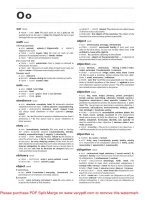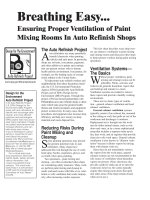Tài liệu Finding Solutions by Being Aware of the Way You Think docx
Bạn đang xem bản rút gọn của tài liệu. Xem và tải ngay bản đầy đủ của tài liệu tại đây (740.67 KB, 7 trang )
Finding Solutions by
Being Aware of the
Way You Think
1-800-COURSES
www.globalknowledge.com
Expert Reference Series of White Papers
Introduction
It is the task of the project manager to be aware of the larger environment in which her/his project is operat-
ing. One approach that helps the project manager achieve this insight is systems thinking.
Being a systems thinker enables us to perceive the interplay of forces that surround and interact with us.
Systems thinking asks us to go beyond our reactive mindset and our knee-jerk reactions to life.
Now, just having a reactive mindset is not, in itself, a bad thing. For instance, if we don’t react immediately to
putting our hand on a stove burner that has been turned on,
we are going to get burnt! We use this reactive
mindset in many areas of life
. A machine breaks down so we buy a new machine. Or sales drop so we launch a
new ad campaign. This is called event-driven behavior, which in itself is not a bad thing.
In contrast to this event-driven behavior, systems thinking calls us to see the world as ”patterns of behavior
over time”, using Peter Senge’
s phrase
1
. For instance
, there are patterns of machine breakdowns and there are
patterns of buying cycles in which there are sales slumps. If we think about cycles, rather than events, we have
a better chance to anticipate what is coming, rather than just reacting to it when it happens.
However
, if we look at the structure of the pattern of behavior (read – the structure of the cycles we have just
described) then we begin to see what creates the cycles that spawn the events. And once we see at this level,
says Senge
, “we can take actions to change the structures that cause the cycles to happen.”
2
Attention at this
level allows us to alter the source of the cycle rather than just deal with its symptoms, which are the events to
which we normally respond.
These structures of the patterns of behavior are called archetypes. They are fundamental patterns of the way
things work. For example, one of these fundamental patterns is called escalation. An instance of escalation
would be when one company gets ahead;
other companies then feel the success of the first company as a
threat. This leads to more aggressive behavior on the other companies’ part to reestablish their advantage. This
behavior is seen as threatening by the first company and leads it to increase its aggressiveness. Each side uses
aggressive behavior as a defensive response to the others aggression. The structure of this interaction howev-
er, is built on the belief that the welfare of one company is dependent on its relative advantage over the other.
T
his assumption is never questioned,
yet it is the true source of the problem,
and the cause of the aggressive
behavior.
T
he above example of systems thinking demonstrates that these structures are not easy to see
.
T
herefore the
first step toward developing a facility for systems thinking is to make these patterns visible. One way is through
the learning and use of methods that expose our own mental models, namely our own ways of seeing.
Karl Fischer, Senior Principal, MA, MEd, PMP
Finding Solutions by Being Aware
of the Way You Think
Copyright ©2005 Global Knowledge T
raining LLC. All rights reserved.
Page 2
Discovering Our Own Mental Models
Discovering our own mental models, and therefore exposing our hidden assumptions, opens our minds to sys-
tems thinking.
When we enter the world of systems thinking through the door of mental modeling, we do what we tend to
do in any new venture; we look for a guide. My office is filled with books by good guides. However, the one
that I am going to recommend whose guidance we should seek is an older cartoon character by the name of
Pogo. Pogo would wax philosophical at times when various events happened to him and his friends. One of
Pogo’s most famous cautions serves as a prime directive as we approach mental modeling, “We have met the
enemy and he is us!”
Mental models are themselves, hidden assumptions. So we need tools that help us uncover and clarify our-
selves to ourselves. Furthermore, mental models are “in here”, not “out there.” Methinks I see Pogo waving
his arm frantically, trying to caution us about where the problem lies. Senge further explains, “The problem
with mental models arise when the models are tacit – below the level of awareness. To the extent that people
remain unaw
are of their mental models, to that extent the models remain unexamined. And because they are
unexamined, they remain unchanged.”
3
In order to expose our own mental models we will examine several techniques that we can use to “lift the lid”
on our own patterns of thinking, steering us aw
ay from the “unexamined life.”
Senge found, in working with many corporations, that new ideas, initially successful in early tests, failed to be
put into practice because they conflicted with “deeply held images of the way the world works
.”
4
Mental
models are powerful because they shape how we act. Further, they shape how we act because they shape how
we see or perceive. For example; if I believe that silence from my class means approval of my lecture, I will
react completely differently to the students from if I believe that silence from my class means disapproval of
my lecture.
The following are four techniques for opening the lid on our mental models. Let’s see how we can employ
them to our benefit.
1. Recognizing leaps of abstraction
T
he goal here is being aware enough to distinguish what we observe from the generalizations we infer from
our observations. One year in summer school, I had a classmate who was noticeable by his silence. He didn’t
talk very much, either in class or out. Most of the other students steered away from him, since their overtures
at inviting him into a conversation never seemed to get anywhere. Our assumptions about his behavior ranged
from “he doesn’t care about other people” to “he thinks he’s better than the rest of us” and everything in
between.
One afternoon he and I crossed paths after a physics class. I thought I would try something. I asked
him for his help in working through one of the concepts and assignments in physics with which I was having
trouble. His reaction was dramatic, to say the least. He looked stunned but agreed to meet with me on
Saturday morning. I will never forget that Saturday, because I not only learned physics. I learned that this fel-
low had a speech impediment. It was very minor. He was painfully embarrassed about his speech impediment
however
,
and therefore reluctant to engage anyone in conversation. My willingness to challenge my own
assumptions freed everyone that summer.
Copyright ©2005 Global Knowledge T
raining LLC. All rights reserved.
Page 3
H
aving this kind of “courage” requires several mental attitudes:
1. We have to be willing to examine our beliefs about the way the world works.
2. We have to be willing to entertain that these beliefs may be generalizations and that, as generaliza-
tions, they could be inaccurate or misleading.
3. We have to be able (or at least willing) to site the data on which our assumptions are based.
This last point underscores our willingness to test our generalizations, which leads into inquiring into ones
own as well as another’s actions. Practicing this type of awareness in order to raise the level of our own
behavior to a higher level of consciousness is a discipline.
I once took a course on Social Change. The professor discussed the dynamic of how perceptions become reali-
ty. According to the professor, any experience is taken in through the view of a previous perception. That per-
ception is colored by an attitude which, when confirmed, becomes a belief. Eventually the belief will become a
value, and when this happens, the process becomes reversed. Values will color beliefs which, in turn, will color
attitudes, which, in turn, will color perceptions which, in turn, will color opinions which, in turn, will color
experiences
. This process can only be stopped by raising our level of consciousness so that we can be aware
what we are doing.
2. Exposing the left-hand column
Often in certain situations, where we anticipate danger or discomfort, we react in a way that is counter-pro-
ductive to our improvement and to a positive resolution of the situation. We do this by remaining unconscious
about our negative reactions.
“Exposing the Left-Hand Column” is a technique that assists in raising our level of consciousness by revealing
ways that we manipulate situations to keep from dealing with what we actively think and feel.
To practice this technique, we start with a situation where we are interacting with one or several people in a
way that we feel is not working. We practice the ‘Left-hand column’ exercise in the following manner. On the
right side of a sheet of paper we write a script that duplicates the exchange between ourselves and the other
party
. On the left side we write what we are thinking but not saying. When we review the left hand column we
discover the assumptions that we have made (they will be there, don’t worry!) It is these assumptions that
govern the behavior described in the right-hand column.
The following conversation, quoted from Senge, is an excellent example.
5
The left column below is the
thoughts in the mind of the Project Manager about Bill. The right hand column is the actual interchange
between the two. It is Bill who has given the presentation.
Copyright ©2005 Global Knowledge T
raining LLC. All rights reserved.
Page 4
What the project manager What is said
is thinking
Everyone says the presentation PM: How did the presentation go?
was a bomb.
Does he really not know how bad it was? Bill: Well, I don’t know. It’s really too early
Or is he not willing to face up to it? to tell. Besides, we’re breaking new ground here.
PM: Well, what do you think we should do? I
believe that the issues you were raising are
important.
He really is afraid to see the truth.
If he Bill: I’m not so sure. Let’s just wait
only had more confidence
, he could and see what happens.
probably learn from a situation lik
e this.
I can’t believe he doesn’t realize
how disastrous that presentation
was to our moving ahead.
I’ve got to find some w
ay to PM: You may be right, but I think
light a fire under the guy. we may need to do more than just that.
I have underlined the assumptions that the Project Manager is making. The last one underlined is the action
planned by the Project Manager that is based on the assumptions. To the extent that these assumptions, on
the left hand column,
are unrecognized they will remain untested.
And to the extent that they remain untest-
ed, they will keep learning from happening in a conflict situation.
The w
ay to overcome this is to share the information in the left hand column with the person with whom you
are in potential conflict. You may find that the other person shares neither the data nor the view of the data
that you have
,
but that is the beginning of true communication.
What you are looking for is a path which will
allow you both to learn.
3. Balancing inquiry and advocacy
We expect a leader (read: project manager) to speak out, define, create rules and direction. This behavior in a
leader is seen as advocacy for his or her position and a positive quality
.
But advocacy is a spiral process evi
-
denced by increasing intensity of use. The more we do it, the better we get at it. It becomes our tool of choice.
Advocacy becomes the answer for every situation.
However, as one grows in a position of leadership, one faces more of the unknown, and the more complex the
problems become. Confronting this unknown requires wisdom, and this wisdom may best be available from
others
.
So the leader needs to ask questions
.
T
his can be done by the simple act of having the leader state out
loud his/her view(s) and the supporting reason(s). Then simply have the leader inquire into the view of the per-
son next to them. Senge says again, “The goal of advocacy is to win the argument. The goal of inquiry with
advocacy is to find the best argument.
”
6
Copyright ©2005 Global Knowledge T
raining LLC. All rights reserved.
Page 5









